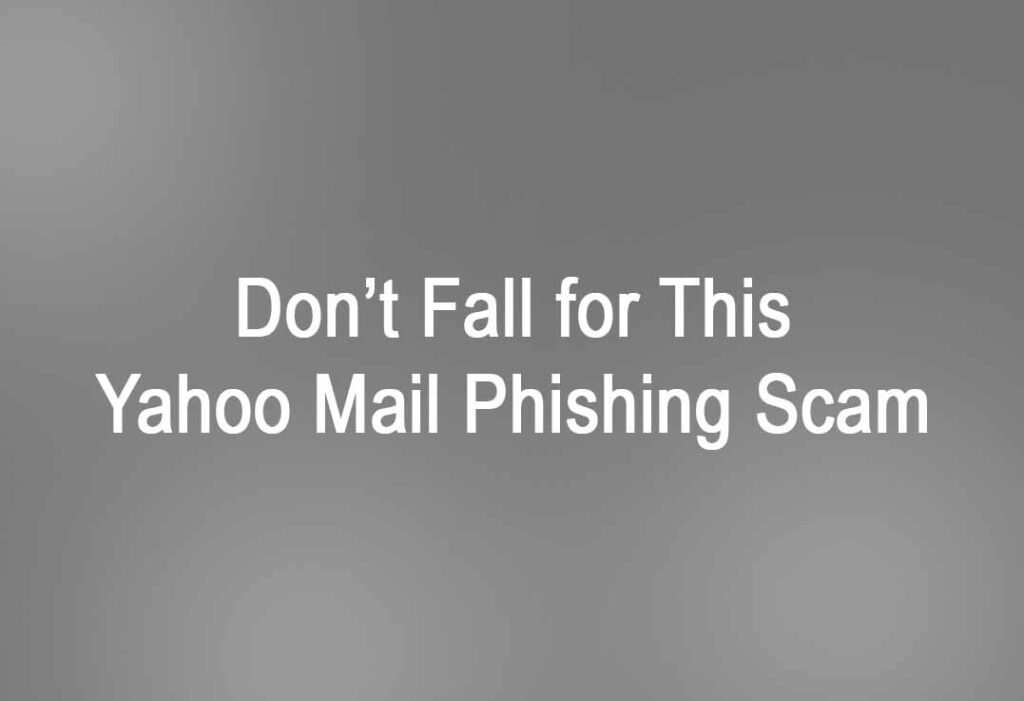Phishing scams targeting email accounts, including Yahoo Mail, are unfortunately common. These scams are designed to trick individuals into revealing their sensitive information, such as usernames, passwords, or personal details. To protect yourself from falling victim to a Yahoo Mail phishing scam, here are some essential tips:
- Be Skeptical of Unsolicited Emails: Be cautious when receiving emails, especially if they’re unexpected or from unknown senders. Phishers often impersonate trusted entities like Yahoo to deceive you.
- Check the Sender’s Email Address: Verify the sender’s email address. Legitimate communications from Yahoo will come from an @yahoo.com email address. Be cautious of any variations or strange domain names.
- Don’t Click on Suspicious Links: Avoid clicking on links or downloading attachments from emails that seem suspicious. Hover your mouse over links to see the actual URL they point to, and verify it matches the legitimate Yahoo website (https://www.yahoo.com).
- Check for Grammatical Errors and Typos: Phishing emails often contain spelling mistakes, grammatical errors, or awkward language. Be on the lookout for these signs.
- Verify the Request: If the email claims that you need to update your password, confirm its legitimacy by independently accessing your Yahoo Mail account through your browser instead of clicking links provided in the email.
- Use Two-Factor Authentication (2FA): Enable 2FA for your Yahoo Mail account. This adds an extra layer of security by requiring a one-time code sent to your mobile device when logging in.
- Stay Informed: Keep up to date with the latest phishing threats and scams. Yahoo and other email providers often provide information and guidance on their websites or through security alerts.
- Report Suspicious Emails: If you receive a suspicious email that appears to be a phishing attempt, report it to Yahoo Mail. They can investigate and take appropriate action.
- Regularly Update Your Password: Change your Yahoo Mail password periodically and use a strong, unique password that includes a combination of letters, numbers, and symbols.
- Use an Email Security Service: Consider using an email security service or antivirus software that can help detect and filter out phishing emails.
- Educate Yourself and Others: Educate yourself and your family members or colleagues about the dangers of phishing scams. Awareness is a key defense against these threats.
Remember that phishing scams are constantly evolving, and scammers are becoming more sophisticated in their tactics. Being vigilant and cautious when dealing with emails, especially those requesting personal or sensitive information, is essential to protecting your online security.
- Brand identity elements
 In the vast marketing universe, imagery is pivotal in establishing and nurturing a brand’s identity. A brand’s visual choices are not merely aesthetic decisions but strategic moves that can significantly influence perception and performance. This Picfixs article explores the intricacies of selecting imagery that complements and enhances a brand’s essence, ensuring it resonates with the… Read more: Brand identity elements
In the vast marketing universe, imagery is pivotal in establishing and nurturing a brand’s identity. A brand’s visual choices are not merely aesthetic decisions but strategic moves that can significantly influence perception and performance. This Picfixs article explores the intricacies of selecting imagery that complements and enhances a brand’s essence, ensuring it resonates with the… Read more: Brand identity elements - 100 Best Mountain Captions and Mountain Quotes for Instagram
 Ready to scale new social media heights? Look no further than this treasure trove of 100 exhilarating captions and quotes, handpicked for your Instagram mountain posts!
Ready to scale new social media heights? Look no further than this treasure trove of 100 exhilarating captions and quotes, handpicked for your Instagram mountain posts! - Symmetry in Photography: A Creative Approach with Examples
 Delve into the enchanting realm of symmetry in photography as we showcase mesmerizing examples on our website. Experience the allure of perfectly mirrored images!
Delve into the enchanting realm of symmetry in photography as we showcase mesmerizing examples on our website. Experience the allure of perfectly mirrored images! - 11 Quarantine Photoshoot Ideas to Try at Home for Amazing Photos
 Looking for unique photoshoot ideas during quarantine? Explore the 11 creative suggestions that will help you capture unforgettable moments at home.
Looking for unique photoshoot ideas during quarantine? Explore the 11 creative suggestions that will help you capture unforgettable moments at home. - 10 Must-Try Spotlight Photoshoot Ideas and Tips
 Capturing the perfect shot requires creativity and attention to detail. Here are 10 fantastic ideas and tips to help you create stunning photos during your next spotlight photoshoot.
Capturing the perfect shot requires creativity and attention to detail. Here are 10 fantastic ideas and tips to help you create stunning photos during your next spotlight photoshoot.


